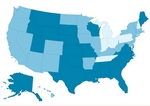business
N.C. Blues' request for 7% rate hike is lowest in 3 years
■ The company says the higher costs, pending approval from the state Dept. of Insurance, reflect changes made to conform to the health reform law.
By Emily Berry — Posted Sept. 8, 2010
- WITH THIS STORY:
- » Related content
Blue Cross Blue Shield of North Carolina has requested a 7% average rate increase for its individual coverage, the lowest such request in three years, according to the company.
About 300,000 people are enrolled in the plans. The proposed rate increases would take effect in 2011.
Blue Cross Blue Shield is the largest insurer in North Carolina, according to the latest American Medical Association report on market competition. The Blues held 54% of the health insurance market, according to the report, which is based on 2007 membership data gathered by HealthLeaders-InterStudy and disseminated in the AMA's report.
The higher rates are pending approval from the North Carolina Dept. of Insurance.
"Rates requested for individual coverage for 2011 reflect medical trend as well as changes made to comply with the new health care reform law," a Blue Cross Blue Shield news release said.
Specifically, the release said the elimination of medical underwriting in 2014 and an end to lifetime benefit limits and mandated coverage for preventive care will raise costs for the company.
North Carolina was among 45 states and the District of Columbia that have received $1 million grants to expand and improve reviews of rate increase requests from health insurers. The Patient Protection and Affordable Care Act allocated the money to states and gave the federal government authority to review and intervene when insurers request "unreasonable" rate increases.
North Carolina will use its grant to seek expansion of its rate review authority and create consumer-friendly information to share with the public about proposed rate increases, according to a news release from the Dept. of Health and Human Services. The insurance department is expected to improve its data collection and reporting capabilities so the public can review rate increase requests.












